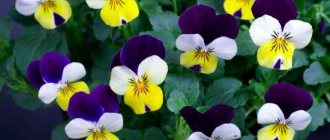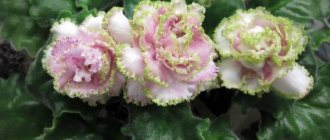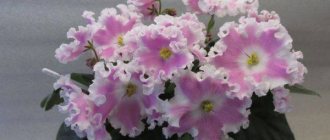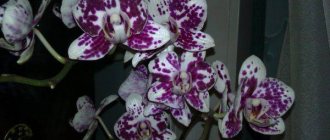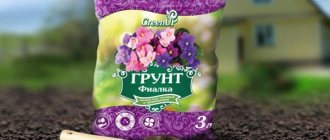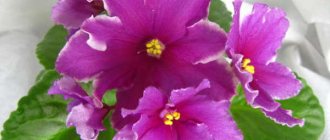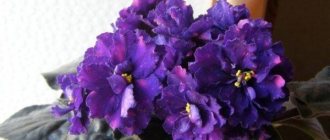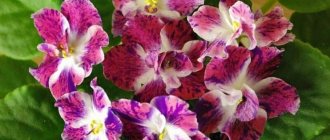Violet YAN-Fairy Tale (N. Puminova)
Genus, family
Uzambara violet. Belongs to the Gesneriaceae family, genus Saintpaulia hybrida.
Luxurious violet YAN Skazka (N. Puminova).
History of the variety
The Yan-Skazka variety is included in the register of varieties by Puminova N.A. The plant was first discovered in 1892 by Baron Walter von Saint-Paul, military commandant of the Uzambara region of the German region.
The German colony was located in the territory of modern Tanzania and Rwanda. Saint-Paul saw the plants while walking around the area around the colony . He collected the seeds and sent them to his father.
Photo and description of the variety
The inflorescences are half-open, the flowering is abundant. Deciduous cover of dark green color, leaf blades:
- Slightly curled upward;
- They have ribbed edges.
The incomparable advantage of this variety is its ease of care .
For successful cultivation, you should follow the following recommendations. Unlike other indoor plants, violet Jan-Skazka:
- Has no rest period;
- And it requires the same temperature throughout the year.
Important! You can use different pots.
Variegation, imprints
Foliage with variegated edges . This trait is preserved at the cellular level of the uterine specimen.
The leaves of the variety have an unusual color.
Sports
There are frequent cases of sporting, i.e. children do not transmit the characteristics of the mother plant . Such instances are called sports.
Who discovered this culture and when?
Violet YAN-fairy tale: photo
The violet was discovered by Baron Walter von Saint-Paul in the east of the African continent, in the mountains. But in fact, it was first discovered by a botanist from Germany, Herman Wendland, and it was to him that the Baron gave the found Saintpaulia. The scientist grew seedlings using seeds and promoted their flowering.
So in 1893, a previously unknown variety appeared, which Wendland classified as a member of the Gesnerieceae family and recorded as “Saintpaulia” (Saintpaulia) after the baron’s surname. The name “Uzambara violet” is also assigned to this crop because of the place where it grows wild, and its flowers are slightly similar in appearance to the inflorescences of violets (viola).
Beginning of selection
The violet was presented for the first time at an international gardening exhibition in Belgium, in the city of Ghent. After which gardeners from Europe began actively cultivating this excellent crop; in 1894, Saintpaulia found its way to the American open spaces, this contributed to the rapid transformation of America into the world center for violet breeding. In 1898, breeders for the first time produced varieties with inflorescences of white, pink, burgundy, and reddish colors; until that moment, people only knew about violet and blue violets.
Saintpaulia appeared on Russian territory in the 50s. twentieth century, they were initially cultivated exclusively in the greenhouse. At the moment, there are more than eight thousand varieties of the most diverse colors, sizes and types, but every year scientists delight with more and more new varieties of this wonderful crop.
Botanical description of the plant
Indoor violet (the second name is Saintpaulia) is a herbaceous plant with a fibrous surface underdeveloped root system. The "Yan" variety is represented by many varieties. They are united by a compact leaf rosette from 15 to 40 cm in diameter and large inflorescences 5–7 cm in diameter. The leaf blades, depending on the variety, can be glossy or pubescent.
Leaf color varies from pale green to dark green, with possible variegated patches of yellow or white flowers, as well as a border along the edge of the leaf. The shape of the leaves is round, sometimes with a pointed tip, in most cases with a serrated edge. Inflorescences can be double or semi-double, basket-shaped or star-shaped.
The color of the petals is varied:
- creamy white;
- pink;
- peach;
- salmon;
- fuchsia;
- blue;
- lilac;
- violet.
Did you know? The first violet with double pink inflorescence “Double Pink Cloud” was presented at the AVSA flower exhibition in 1954.
A copy was sold for $ 1000.
Many varieties have petals edged or interspersed with a more saturated shade than the main background. Saintpaulia "Yang" blooms twice a year, flowering duration is 2-4 weeks, in some varieties - up to 6 weeks. The interval between flowering is approximately 2–4 months, so the dormant period of plants is relative and does not require special attention. After flowering, the violet forms a fruit - a round or spindle-shaped seed pod. Small seeds fall out of the capsule, which, when ripe, is destroyed by moisture.
Varieties
The variety has many varieties, differing in the structure of the inflorescences and color.
The most popular of them:
- violet "Yan Skazka" - a fast-growing variety with serrated, boat-shaped leaves. The leaf blades are variegated, with white splashes. The inflorescences are large in the form of stars, the petals are double, the main color is white-green. In the center of the cup, the petals glow pink;
- "Caprice" - a slow growing plant, blooms 1.5–3 years after planting. The leaf rosette with a diameter of 18–25 cm is formed by smooth leaves with a carved wavy edge. The color of the middle of the leaf is dark green, the border around the edge is white. It blooms with large, double inflorescences up to 5 cm in diameter. The snow-white petals along the wavy edge are colored with a green, less often bronze, tint;
- "Sherkhan" - a compact rosette with pubescent green leaves with a white edging. Star inflorescences with petals wavy along the edge have a rich fuchsia color. The fullness of the petals appears during the second flowering;
- "Morozko" - a neat rosette with dark green leaves, on which a white edging runs along the edge. Star-shaped inflorescences, up to 7 buds per bush, 5–7 cm in diameter. Terry carved petals of snow-white color;
- "Katyusha" - the bush, as it grows, forms a rosette with slightly raised leaf plates up to 20 cm in size. The leaves are bright green with a yellowish splash, which may disappear as they grow. The edges of the plates are jagged. Double or semi-double flowers, 1–3 on one pink peduncle, about 5 cm in diameter;
- "Sahara" - leaves are pubescent, round in shape with a carved edge, colored green with yellow spots. Large, double inflorescences up to 5 cm in diameter, color varies from salmon to bright pink;
- "Pasha" - leaves are round in shape with clear veins, bright green in color. It blooms often and profusely with large double inflorescences up to 6 cm in diameter. Terry petals are pale blue or pale pink, a distinctive feature is purple specks on the main background;
- "Fun" - a loose rosette of light green leaves, up to 40 cm in diameter. When flowering, it is covered with a cap of semi-double inflorescences in the shape of stars. Rich lilac or pink petals along the edge are framed by a border of a darker shade;
- "Madam" - large dark green rounded leaves pointed at the tip. The inflorescences are semi-double, multi-petaled, colored pink.
Violets, domestic varieties
Violets, domestic varieties
–
YAN-Sultan
| The first flowers on a neat young rosette. Bloomed very quickly. | Bright rosette. I threw away a lot of flower stalks. Of the white-blue with finger coloring, I liked it for its compactness | Violet grew a head of flowers |
| Very nice, neat rosette |
Page 1]
Photo albums
- Violets, foreign varieties
- Violets, domestic varieties
- Varieties of Korshunova
- Lebetskaya varieties
- Repkina varieties
- Mini, semi-mini
- Trailer violets
- Chimeras
- Episces
- In the interior, or how we grow
- Daughter's orchids
- Winners and prize-winners of photo exhibitions
© 2011-2016, “Violets in Altai”
Personal website of Tamara Bobina,
Site Map
e-mail:
Website development "Active Design"
Growing Tips
In order to grow this wonderful variety at home, you should carefully study the following recommendations from experienced gardeners.
- Landing. Pots for planting violets should not be very large. Ideally, the recommended diameter of the pot is three times smaller than the rosette of the plant. Leaf cuttings and “babies” can be grown in small plastic cups, while adult specimens should be grown in clay or plastic pots. When planting, you can use ready-made soil for Saintpaulias or make a mixture of leaf soil, turf, coniferous soil and peat in a ratio of 3: 2: 1: 1. Don’t forget to add a baking powder to the soil: perlite, vermiculite or sphagnum moss. It is necessary to update the soil mixture in adult plants every two to three years.
- Lighting. The plant requires good lighting for at least 13–14 hours daily. In winter, this violet should be kept on the window next to the glass and additional lighting should be used. In summer it is necessary to shade it from direct sunlight.
- Temperature. This variety likes warmth (20–22 degrees Celsius). But if you do not keep the plant cool at the stage of bud formation, then the characteristic green lines on the flowers will not form.
- Air humidity. This flower loves humidity - it should be at least fifty percent. However, you should not spray the violet with a spray bottle. It is better to place it on a tray with moistened pebbles or place a container of water nearby. Once a month you can arrange a hygienic shower, but after that be sure to remove all the water that remains on the leaves.
- Watering. Despite the general unpretentiousness of this variety, the plant needs to be watered regularly with settled soft water at room (or slightly higher) temperature. You can also water through a tray and using the wick method. The main thing is to avoid water droplets getting on the leaves and rosette.
- This variety grows quickly , but it is necessary to feed the flower with special fertilizers during the period of active growth and at the stage of bud formation. In autumn and winter, the plant does not need fertilizing.
Beginning gardeners should remember that for good flowering violets need potassium and phosphorus, and for strong leaves - nitrogen.
Caring for a plant at home
Violets are planted in a small pot . The variety is propagated by cuttings into small plastic cups:
- Adult specimens are grown in clay or plastic vessels;
- Before planting, prepare the soil mixture. To do this, you need to mix turf, leaf, coniferous soil and sand in a ratio of 3:2:1:1. You can use a ready-made substrate for Saintpaulia;
- If desired, you can add a baking powder (perlite, sphagnum, vermiculite) to the soil.
Conditions for keeping the variety
A common reason for the growth of this plant to stop is irregular watering . If the top layer of soil is dry, then it's time to water.
In the first time after acquisition it is not advisable to replant ; if the Saintpaulia was grown in peat, the replantation should be carried out immediately.
Proper watering and fertilizing
During the daytime, the plant should receive the maximum amount of sunlight , but it should avoid direct sunlight. And if the plant is grown in winter, then it will need an additional light source.
For Saintpaulia, you need to choose the right watering.
to fertilize the plant not with dry fertilizers , but with liquid ones.
Attention! Fertilizer should be added every sixth watering of a given flower.
Lighting and air temperature, what is better for the plant: heat or coolness?
The variety is quite demanding in terms of light conditions. Continuous lighting should continue for a minimum of fourteen hours each day. Temperature regime for violets:
- The ideal temperature for Saintpaulia is 20-25 degrees Celsius . At temperatures above 30 degrees, the plant becomes lethargic, its growth and development slow down significantly, at temperatures below 15 degrees the plant gradually dies;
- The optimal water temperature for irrigation is the air temperature in the room where the flower grows;
- When the plant begins to form buds, it must be placed in a cool place , otherwise there will be no green streaks on the flowers.
How does air humidity affect a plant?
If the temperature and humidity conditions are not suitable for violets, you can grow new plants from the strongest leaves.
Violet does not tolerate:
- Temperature changes;
- And dry air.
In summer, under no circumstances should a flower be taken outside, because even the smallest draft can harm the plant.
Violets love moist air.
What kind of soil does the plant prefer when growing at home?
In the first days after planting, the plants will need abundant watering. These days, it is advisable to water with warm, settled water with the addition of wood ash.
Soil for violets can be:
- Prepare from: Chernozem;
- Sand;
- And ash.
Methods of propagation of the variety
Growing this flower from seeds cannot be called difficult.
In this matter, the main thing is to strictly follow the planting recommendations and everything will be fine:
- First, thoroughly sift the top layer of soil mixture. Then fill the pots or other containers with it;
- After the above event, the soil must be left alone for some time until it dries completely;
- Then simply pour the grains onto the ground and sprinkle soil on top. After that, water the whole thing generously.
Rules for transplantation, plant rejuvenation
In the first days after transplantation, you need to create a microclimate for the plants using:
- Films;
- Or glass.
Transplanted specimens must be protected from drafts . Saintpaulias are illuminated in the morning and evening for two hours. It is also necessary to rejuvenate old violets.
Saintpaulia needs to be replanted once a year.
Attention! The first fertilizing with complex fertilizer is carried out 15 days after emergence.
Features of flowering, growth and reproduction
The buds are formed on shortened peduncles. Saintpaulia flowering:
- Abundant;
- Long lasting;
- Up to 60 days.
Violet loves warm and moist soil . The soil temperature should not be less than 20 degrees Celsius. At low temperatures, the plant does not produce flower buds.
If you decide to grow Uzumbara violet at home, then you need to know:
- The temperature for growing should range from 20 to 25 degrees in summer;
- If you grow a flower in winter, then the temperature should not fall below 15 degrees.
How does a plant develop?
Planting of leaves is carried out after roots form on the cuttings after a long stay in water. Before planting, the leaves must be kept in water for some time. The water needs to be changed periodically to avoid rotting of the petiole.
How long does it take to grow an adult plant?
From a rooted cutting you can get a full-fledged flowering plant in 2.5 – 3 months .
The young plant blooms in 3 months.
Attention! The plant should be planted in soil that has been passed through a sieve. For a couple of days, you need to cover the plant with a plastic bag or jar.
Methods and features of variety propagation, how are varietal characteristics transmitted?
The cutting method is considered the easiest to perform , which is the reason for its popularity:
- The most important point is the choice of leaf; it must be large, intact and cut from a flowering plant;
- Before planting, the leaf must be placed in warm boiled water for a couple of hours, to which a small amount of potassium permanganate must be added in advance, this is necessary in order to disinfect the leaf;
- The cuttings of the above-mentioned leaf are cut at a right angle and planted in loose soil.
Peculiarities
Currently, there are two varieties of violets with the same name “Fairy Tale”. The first is a varietal violet bred by Natalya Puminova, and the second is a plant by breeder Alexey Tarasov. Since these violets have little resemblance in appearance, when purchasing, pay attention to the prefix before the name of the flower. Capital letters before the variety name most often (but not always) indicate the initials of the breeder. Violets bred by Natalya Puminova have the prefix “YAN”, and flowers selected by Alexey Tarasov have the prefix “AB”.
Distinctive features
Professional collector N. Puminova abandoned the traditional wick watering of violets . Despite the fact that violets grow and bloom well thanks to this method, violets growing on wicks grow excessively large rosettes that do not always ripen, and the seed pods of the plants deteriorate. In addition, according to the specialist, jars with laces do not have an entirely aesthetic appearance. Therefore, the breeder recommends using the usual watering method.
The most important feature is the desire for perfection and unprecedented demands on the results of one’s creativity. It is known that Natalya Alexandrovna produces new varieties infrequently, little by little. What is the reason for such slowness? Of course, with quality. New varieties undergo strict and careful selection, and then only the violet variety receives a name and becomes a real masterpiece.
The master’s criteria are not simple: the rosette must be neat, she gives preference to small standards, but at the same time the flowers must be large and preferably have strong peduncles , and the flowering must be rich and abundant.
Reference! Now work is underway to create a variegated violet, the results are in - an unusual violet with rich red blooms has been developed. “There must be harmony,” says Natalya Alexandrovna, creating her samples, striving for perfection.
The main argument and argument in favor of growing violets is very simple and clear. Wonderful violets are compact, they can be placed throughout the house, and with proper care they bloom almost all year round! And the richest range of colors can always “decorate” even the most gray and colorless everyday life, filling the house with joy and harmony.
Reviews about violet
Olga. “The variety pleased me. The only drawback is that the flowers fall off too quickly. This may be due to incorrect temperature conditions. I’ll try to fix everything and continue to monitor.”
Natalia. “I didn’t have any problems with the violet, but to be honest I expected that
terryness
will be more pronounced. Also, from my own experience, I want to warn everyone that when the soil is waterlogged, the roots will rot.”
Svetlana. “Almost immediately I encountered
decay
leaf petioles. Apparently this was due to excess water. In all other respects, the variety completely satisfies me.”
Violets from the Moscow fairy Natalia Puminova: Jan-fairy tale, Fun, Madame and others
Natalya Aleksandrovna Puminova is a real fairy of violets. She creates real miracles with her hands. The flowers she produces fascinate, envelop with tenderness, delight the eyes, and give warmth.
Natalya did not come to breeding work right away. She wanted to see something unusual and unusual on her shelves, and getting the plants she wanted was not easy.
Selection gave her the opportunity to create something unique, unlike other flowers in the collection.
Features of flowering varieties in hot and cool conditions
High positive temperatures are a stress factor for the plant. The pot needs to be placed in a slightly shaded place , where there is no direct sunlight, and not near a radiator; the flower does not like dry air. Grows well on northern windows.
Saintpaulias must be shaded from direct sunlight.
What do flower stalks look like?
Peduncles are shortened and compact. The flowers are abundant, simple, blue-blue, slightly folded stars with a wide white border. Flowering cap.
Is it possible to achieve cap flowering from a variety?
For abundant flowering in the form of a cap, you do not need to make any special efforts . The Yan Skazka variety is precisely created for this kind of flowering.
Duration of flowering bud
It usually blooms for 2 months. Peduncles are formed in the leaf axils . Peduncles form only if they have enough light.
TOP 10 most popular varieties
Admire the violets below. How diverse and beautiful the world of Saintpaulia is. Each of them contains the soul and feelings of the author who created such beautiful creations.
LE-Pauline Viardot
The author of the unusually beautiful Saintpaulia is Elena Lebetskaya (Vinnitsa, Ukraine). The violet is named after the famous singer and composer.
Flowers are in the form of large semi-double stars, 8 cm in diameter, color – wine red. Petals with a wavy edge and a white, thin edge.
The leaves are variegated, on long stalks, the rosette is large.
To achieve cap flowering, it is necessary to provide the violet with sufficient illumination - at least 12 hours a day. It grows slowly.
EK-Magic of Love
This Saintpaulia is the creation of breeder Elena Korshunova (Tolyatti).
The flowers are quite large, double, form a bouquet, the color is beet red, the edging is white. Flowering is long-lasting and abundant.
The leaves are bright, emerald green. The socket is standard, smooth.
This Saintpaulia is thermophilic and light-loving, afraid of direct sunlight.
Advice! By providing proper care, you can get a well-groomed, beautiful plant.
AB-Black Prince
The author of the exquisite variety is Violet grower (Tarasov A.V.).
The flowers are double large stars, 6.5-7 cm in diameter, the color is deep black-red, contrasting with the bright yellow anthers. The petals are wavy, slightly elongated, forming a lush cap.
Flowers darken with age. For abundant flowering, you need to provide a sufficient amount of light.
The leaves are dark green, the reverse side is red. The shape is oval. The socket is standard.
EK-Malachite orchid
This original, elegant Saintpaulia was grown by breeder Elena Korshunova (Tolyatti).
The flowers are double, large, purple-cherry in color, with a wide, green border. At low temperatures, most of the flowers become green; a purple-cherry stripe remains only in the middle of the petals. Blooms with a luxurious cap.
The leaves are bright, juicy, green, pointed in shape. The socket is standard, neat, even.
Saintpaulia grows quickly and is easy to care for.
RS-Don Juan
Airy, graceful variegated Saintpaulia grown by Svetlana Repkina (Lugansk).
The variety is not capricious. With standard care it pleases with beautiful flowering. To prevent the petioles from stretching, you need to provide good lighting.
The flowers are star-shaped, purple-black or violet with a light green or yellow ruffle. The flowers last a long time.
The leaves are dark green with pink edges. The socket is standard, with a diameter of 40 cm.
Mac's Black Uhuru
This bright beauty is from the collection of breeder George McDonald (McDonald, George). Saintpaulia semi-miniature. Requires strict adherence to agricultural technology.
The flowers are large, deep, bright, purple-black with a very thin white edge. The flower stalks are slender, succulent, each with a beautiful bouquet. Blooms for a long time.
The leaves are strong, dark green, quilted.
AV-Kindzmarauli
The author of the magical variety is Violet grower (Tarasov A.V.).
The flowers are velvety large stars, the color is noble burgundy, wine, the bouquet is large. The structure of the petals is wavy. It blooms for a long time, abundantly, in the form of a cap.
The leaves are bright, green, slightly pointed, jagged. The socket is standard, neat, and compactly located.
Can switch to sports. Easy to grow. No special care required.
Dancin' Trail
The author of this wonderful semi-miniature is Paul Sorano.
The flowers are double, large stars, dark red in color. Peduncles are tall and dark. You will have to wait a long time for the first flowering, up to 1.5 years. But then they bloom almost constantly.
The leaves are small, shiny, dark green with pointed ends. The reverse side of the leaves is red. Forms beautiful bushes and grows quickly.
LE-Chateau Brion
This bright beauty was born by breeder Elena Lebetskaya (Vinnitsa, Ukraine). Saintpaulia grows easily and blooms quickly.
The flowers are in the form of large double stars, form a beautiful ball, the color is dark, wine-ruby. Along the edge of the petals there is a thick, slightly corrugated white border.
Peduncles are vigorous and strong. It blooms captically. Doesn't like bright sun, burns out.
The leaves are bright green, oblong. The socket is standard, smooth.
Characteristics of the variety “AV-Skazka”
Alexey Tarasov (also known as Fialkovod) is a young but already quite famous Moscow breeder. He has not been engaged in selection for a very long time, but during this time he has developed spectacular varieties of violets, for example, “AV-Polar Bear”, “AV-Crimean Cherry”, “AV-Mexican Jerboa”, “AV-Plyushevaya”, “AV-Natasha” Rostov", "AV-Gypsy Wedding" . Alexey tries to create plants that are unique, varied in flower shape and color, and do not require special care.
Violet "AV-Skazka" was bred by a breeder in 2016. It has a “small standard” size, a neat, strong socket. She has very beautiful semi-double white flowers, the shape of the inflorescence is similar to a pansy. The petals end in spectacular waves and an unusual swamp-crimson border. The leaves of this variety are simple green in color, slightly wavy at the edges.
Description of the violet variety Jan-Caprice
The plant of this variety is very unusual and original. Its flowers are creamy white, decorated along the edge with small greenish, bronze or pink teeth, double or semi-double. Blooms with a cap.
The leaves are variegated, decorated with a white border, curly. Peduncles are erect and strong. One usually produces from 3 to 5 flowers.
The leaf plate is glossy, but due to the wavy edges, the impression of velvety is created. On young violets, the variegation of leaves is almost invisible, but as they grow, the velvety light border becomes more and more bright and noticeable. In normal lighting, the leaves seem to hug the pot.
The blooming violet of this variety is very harmonious. An openwork bouquet, creamy white, decorated with a greenish, bronze or pink border almost merges with the dark greenery of variegated leaves.
In good light they “hug” the pot. The flowers are double or semi-double, strongly corrugated along the edge of the openwork petals. On one flower, on different petals, the frills can be of different colors.
Features of the Isadora violet, its photos and differences from other varieties
A common hobby among people is floriculture.
Flowers are loved for their decorative functions (filling space with beauty). They are also used for medicinal purposes and as spices. Of the hundreds of types of flowers, there are those that are undemanding to care, among them violets can be distinguished. This is one of the most popular indoor plants.
There are more than hundreds of species of violets. One of the most common varieties is “Isadora,” which you will learn about in this article.
Reviews
Dina Dovlatovna. “The variety “23-Faberge Smile” attracted my attention with its unusual flowering. I love flowers with green tints, and here there is such luxury: both the green buds and the corollas with a greenish-brown tint of the petals. I couldn't resist and bought it for my collection. Moreover, the variety tolerates heat well - just for my conditions. The only drawback I can name is the slow flowering.”
Valentina. “I received a leaf of Saintpaulia “23-Faberge Smile” by accident at an exhibition. I was surprised that many children were born without problems. But they grew for an insanely long time, and, in my opinion, they were preparing to bloom even more slowly. For about a month I admired small green balls with incomprehensible, torn contours. And then gorgeous roses from a mixture of shades opened. This is my first bloom so far, only four flowers. And my friend’s violet is blooming actively and looks like a green cake with a sea of whipped cream on top.”
